
Best Canadian Investment Options for NRIs
Best Canadian Investment Options for NRIs with a View to Returning to India
Explore the best Canadian investment options for NRIs planning to return to India. Learn about RRSP, TFSA, real estate, mutual funds, and NRI-friendly financial strategies. Canadian investments for returning NRIs, NRI investment strategy Canada.
Many Non-Resident Indians (NRIs) who live and work in Canada eventually plan to return to India. Choosing the right investments before moving back is critical to ensure your wealth continues to grow and transfers smoothly. This guide explains the best Canadian investment options for NRIs who have a future plan to settle in India, along with tax rules, withdrawal considerations, and strategic advice to make your financial transition easier and more profitable.
30 FAQs on Canadian Investments for Returning NRIs
Long Answer: For NRIs planning to return, a mix of Registered Retirement Savings Plan (RRSP), Tax-Free Savings Account (TFSA), Guaranteed Investment Certificates (GICs), and diversified mutual funds works best to balance growth and stability.
Long Answer: RRSP offers tax deductions while you are a Canadian resident. You can leave the funds to grow even after becoming non-resident, though withdrawals will later be taxed at 25%.
Long Answer: TFSA is excellent while you live in Canada, but you must stop contributing after becoming a non-resident. You can keep it open but can’t add more money once you leave.
Long Answer: Guaranteed Investment Certificates are backed by Canadian financial institutions and are ideal for conservative investors seeking fixed returns with no market risk.
Long Answer: NRIs can invest in mutual funds through Canadian banks or investment firms. Once you leave Canada, you may need to inform the fund house of your new residency and may face restrictions on new purchases.
Long Answer: Exchange-Traded Funds (ETFs) offer low fees and diversified exposure to Canadian and global markets. They are ideal for NRIs who want long-term growth before returning to India.
Long Answer: Real estate can provide rental income and appreciation, but it ties up capital. If you plan to return soon, selling before leaving helps simplify taxes and currency transfers.
Long Answer: Canadian stocks offer strong returns in sectors like banking, energy, and telecom. However, manage them through registered accounts to reduce tax on capital gains.
Long Answer: Many Canadian brokers restrict non-resident clients. Check your brokerage policy or transfer holdings to a non-resident–friendly institution before leaving.
Long Answer: NRIs pay a 25% withholding tax on investment income such as dividends, interest, and RRSP withdrawals. Some taxes can be reduced under the Canada–India Tax Treaty.
Long Answer: You can leave your RRSP invested and withdraw funds later. Withdrawals are taxable in Canada but may be reported again in India with tax credit under the treaty.
Long Answer: Since India taxes TFSA income, withdrawing and reinvesting in Indian assets may be more efficient if you plan to become a permanent resident in India.
Long Answer: You can contribute to Canada Pension Plan (CPP) or employer pensions while working in Canada, but not once you leave the country.
Long Answer: Withdraw your investments, convert to CAD cash, and remit to India via bank transfer. Declare the income in both countries and comply with RBI’s Liberalised Remittance Scheme if applicable.
Long Answer: GICs offer higher interest rates and guaranteed returns compared to normal savings accounts, making them a secure short-term option before moving.
Long Answer: Government bonds are safe, low-risk options. You can hold them until maturity or sell anytime. They suit conservative investors nearing relocation.
Long Answer: Dividend-paying stocks provide steady income, but NRIs face a 25% withholding tax on dividends. The net yield remains attractive if held long-term.
Long Answer: Avoid long-term or non-transferable investments such as real estate with heavy mortgage or locked-in funds, as liquidating them later can be complex and taxed.
Long Answer: You can maintain Canadian bank accounts to manage income or investments, but notify your bank about your non-resident status for proper tax handling.
Long Answer: If CAD is strong, converting before moving might yield better returns. Otherwise, keep funds in CAD and transfer gradually through legal banking routes.
Long Answer: Low-risk, short-term investments like GICs, Treasury bills, or money market funds preserve capital and offer stability before repatriation.
Long Answer: When you sell Canadian property as a non-resident, CRA charges capital gains tax. File NR6 or Section 116 clearance before completing the sale.
Long Answer: You can send proceeds to India and invest in mutual funds, fixed deposits, or real estate. Ensure all funds are repatriated through NRO or NRE accounts.
Long Answer: Life insurance policies provide financial security but limited investment return. It’s better for family protection, not wealth growth.
Long Answer: Canada Pension Plan (CPP) and Old Age Security (OAS) benefits can be paid abroad, including India, once you meet the eligibility years of contribution.
Long Answer: Consulting a cross-border financial planner ensures your investments, taxes, and transfers align with both Canadian and Indian regulations.
Long Answer: Indian residents must disclose global assets and income in the Indian tax return under Schedule FA, including Canadian accounts or investments.
Long Answer: Keep part of your assets in CAD and part in INR-linked instruments. Avoid converting everything at once to reduce exchange rate risk.
Long Answer: Diversifying between Canada and India spreads risk. Keep some funds in Canadian markets for stability and others in Indian assets for faster growth.
Long Answer: Focus on easily accessible, low-risk Canadian assets like GICs and RRSPs, prepare for taxation during withdrawal, and plan a gradual transfer of funds to India through official banking channels.




